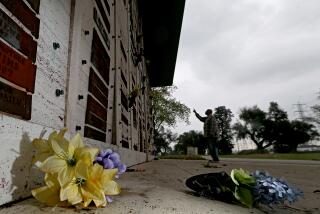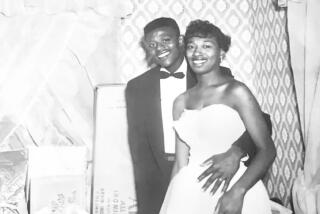Teens Say Curiosity Prompted Grave Robbery : Connecticut: As part of punishment, judge orders youths to find out all they can about Oliver Covell and write a paper about his life and times.
- Share via
KILLINGLY, Conn. — A full moon was painting a phantasmagoria of shifting shapes and shadows among the mossy tombstones in the Covell Family Cemetery as four dark figures came slinking past the graves.
It was Jeff Goodno and three teen-age friends--up to no good.
The skulking youths weren’t concerned about the possibility of ghosts and ghouls. Nor were they afraid of the eerie shadows. They had come into the old, overgrown cemetery to dig up the bones of Oliver Covell, a 19th-Century farmer who lay buried beside his wife Candace.
On that April night, Covell’s eternal rest would be disrupted. But in the end, his tormentors would be brought to justice, and their punishment would fit the crime--they would be forced to get to know the living, breathing human being whose bones these once were.
*
“We started at midnight,” recalled Goodno, a talkative 18-year-old. “There was a full moon, and a thin layer of fog was creeping across the ground. It was just like something you’d see in the movies.”
With Goodno that night were Jeremy Coutu, Eric Cline and Joshua Tate, all juniors at the Danielson technical school.
“We wanted to see what a skeleton looked like,” Goodno said. “We picked Oliver because he had the biggest gravestone.”
He said it took a couple of hours to dig up Covell, who died in 1852. The youths took turns shoveling.
“When we got down to the bones, we carefully brushed away the dirt,” Goodno said. “Then we shined our lights down into the grave, and there he was. We just stared in awe. There was nothing left of the casket except a couple of metal hinges. The skeleton was on its back, with the head turned toward the left and one arm outstretched.”
Coutu’s home is near the cemetery in rural eastern Connecticut, near the Rhode Island border. He said he remembers the night of the grave robbery as “the most enchanting thing.”
But the authorities weren’t enchanted. They learned about the grave robbing when Goodno took Covell’s skull to school and placed it on his desk after a teacher left the room.
“It was in my book bag, along with a femur and a humerus,” when the police came and took it away, he said. “They got the rest of the bones from Josh Tate, who had them at his house. That first night we dug up Oliver we covered him back up, but Josh and I went back a few days later and got the bones.”
Prosecutors originally charged the youths with unlawful disinterment, a felony. Superior Court Judge Robert Martin later allowed them to plead guilty to criminal mischief and criminal trespass, both misdemeanors.
In late August, the judge placed the young grave robbers on probation and ordered them to pay for reburying Covell.
And, at the suggestion of Leslie Ricklin, a professor at Eastern Connecticut State University, Martin also ordered them to find out all they could about Covell, and to write a paper about his life and times.
“I wanted these boys to realize that Mr. Covell was not just a collection of bones,” Ricklin said one recent afternoon as she met with Goodno, Coutu and Cline in the records room at the Killingly Town Hall.
“The boys asked me to meet with them on a weekly basis,” she said, hauling down a massive bound volume of records. “They’re finding out a lot about Mr. Covell, and about how people lived in the early part of the 19th Century.”
They now know, for instance, that Oliver Covell was a frugal, hard-working man who fought in the War of 1812.
“We found an inventory of his belongings at the time of his death,” Goodno said. “It showed old Oliver had 100 pounds of beef and 50 pounds of ham in his smokehouse when he died, back in the spring of 1852.”
Coutu, Goodno, Tate and Cline--with Ricklin’s help and guidance--have dug up Oliver Covell’s will, marriage license, land-purchase records and the minutely detailed inventory of his earthly possessions when he died at age 67.
“He was in Sgt. Brayton’s company in the War of 1812,” said Coutu. “He bought his land in 1816 for $2,900, was married to Candace Martin on April 13, 1825, and had an estate valued at $4,173.11 when he died, including $139.45 in cash.”
His estate also included two pairs of woolen drawers, valued at 30 cents. In addition to the drawers, the acreage and the various farm animals and equipment, the estate included a keg of molasses, two barrels of vinegar, 50 pounds of tallow--valued at $5--and an old silk hat worth 5 cents.
“We also found an old map, showing who owned land back then,” Coutu said.
“But we haven’t been able to find out whether the Covells had any children. As far as we know, he doesn’t have any relatives living around here now.”
Ricklin says her young charges have been enthusiastic, for the most part, in their efforts to learn more about the man whose grave they so rudely disturbed.
“Actually, we’re kind of enjoying this,” Goodno said.
“We wanted to find out more about Covell anyway, and now we have the excuse to do it, and we have someone to help us find the resources we need to do it.”
More to Read
Sign up for Essential California
The most important California stories and recommendations in your inbox every morning.
You may occasionally receive promotional content from the Los Angeles Times.













